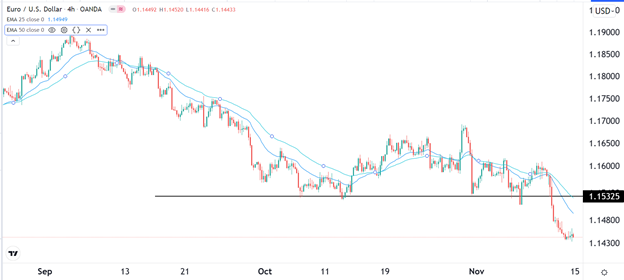Bullish View
Buy the EUR/USD pair and add a take-profit at 1.1500.
Add a stop-loss at 1.1380.
Timeline: 1-2 days.
Bearish View
Set a sell-stop at 1.1400 and a take-profit at 1.1300.
Add a stop-loss at 1.1500.
The EUR/USD price is hovering near its lowest level since July 2020 as investors reflect on the rising American inflation and the potential for a tighter global tightening process. The pair is trading at 1.1443, which is about 2.2% below the highest level in October this year.
Worries of Stagflation
The US and Europe have transitioned from a COVID-related recession to a potential phase of stagflation. Stagflation is a period that is characterized by high inflation and relatively slow growth.
For example, recent data showed that the American economy expanded by just 2% in the third quarter. This was a significant decline considering that the economy bounced back by more than 5% in the second quarter.
At the same time, inflation has surged as energy prices and supply gridlock rise. Data published this month revealed that the American Consumer Price Index (CPI) rose by 6.2% in October. This was the highest inflation level since 1991.
Therefore, while the unemployment rate is falling, the American growth rate is still under pressure. As such, there are worries that inflation will stay at elevated levels while the overall recovery will remain slow.
At the same time, the Federal Reserve will likely accelerate its tightening program in a bid to tame the runaway inflation. Indeed, the bond market seems to be preparing for more tightening, The 10-year bond yield has risen to 1.570% while the 30-year yield has risen to 1.938%.
Meanwhile, the EUR/USD pair has also dropped because of the rising number of Covid-19 cases in some European countries. Germany has continued to see elevated number of cases in the past few days. Similarly, countries like Netherlands and Austria have also announced some curbs to tame the disease.
EUR/USD Forecast
The four-hour chart shows that the EUR/USD pair has been in a major sell-off in the past few weeks. The pair has managed to drop below the key support level at 1.1532, which was also the lowest level in October. This price was also along the neckline of the head and shoulders pattern. It has also moved below the 25-day and 15-day moving averages.
Therefore, the pair will likely have a relief rally this week as the break and retest pattern actualizes. This will likely see it retest the key resistance at 1.1500.

